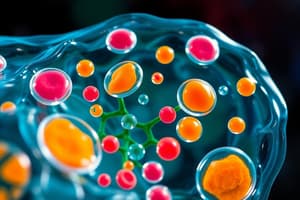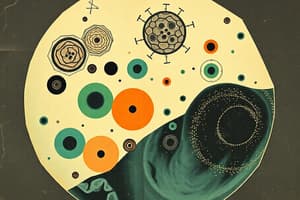Podcast
Questions and Answers
What is the primary function of the plasma membrane?
What is the primary function of the plasma membrane?
- To produce energy for the cell
- To store genetic material
- To regulate what enters and leaves the cell (correct)
- To synthesize proteins
Which organelle is responsible for modifying and packaging proteins and lipids for transport?
Which organelle is responsible for modifying and packaging proteins and lipids for transport?
- Lysosomes
- Endoplasmic Reticulum
- Mitochondria
- Golgi Apparatus (correct)
What is the main function of the mitochondria?
What is the main function of the mitochondria?
- To regulate cell growth
- To produce energy for the cell (correct)
- To synthesize proteins
- To break down cellular waste
What is the primary function of the ribosomes?
What is the primary function of the ribosomes?
Which cellular process involves the breakdown and recycling of cellular waste and foreign substances?
Which cellular process involves the breakdown and recycling of cellular waste and foreign substances?
What is the primary function of the cytoskeleton?
What is the primary function of the cytoskeleton?
Flashcards are hidden until you start studying
Study Notes
Cell Structure
- Plasma Membrane: Semi-permeable membrane that surrounds the cell, regulating what enters and leaves.
- Cytoplasm: Gel-like substance inside the cell where metabolic processes occur.
- Nucleus: Controls cell growth and reproduction, contains most of the cell's genetic material.
- Mitochondria: Produces energy for the cell through cellular respiration.
- Endoplasmic Reticulum (ER): Network of membranous tubules and cisternae involved in protein synthesis, lipid synthesis, and detoxification.
- Ribosomes: Small organelles found throughout the cytoplasm, responsible for protein synthesis.
- Lysosomes: Contains digestive enzymes, breaks down and recycles cellular waste and foreign substances.
- Golgi Apparatus: Modifies and packages proteins and lipids for transport out of the cell.
- Cytoskeleton: Provides structural support, shape, and movement to the cell.
Cell Function
- Metabolic Processes: Cells carry out various metabolic reactions, such as glycolysis, citric acid cycle, and fatty acid synthesis.
- Cell Signaling: Cells communicate with each other through signaling pathways, involving receptors, hormones, and other signaling molecules.
- Cell Division: Cells reproduce through mitosis (somatic cells) or meiosis (gametes).
- Cell Growth and Development: Cells grow and differentiate into specialized cells, tissues, and organs.
- Cellular Response to Stimuli: Cells respond to environmental stimuli, such as light, temperature, and touch.
- Cellular Transport: Cells transport materials across the plasma membrane through passive (diffusion, osmosis) and active (carrier proteins, pumps) transport mechanisms.
Cellular Organelle Interactions
- ER and Ribosomes: ER provides a site for ribosomes to translate mRNA into protein.
- Golgi Apparatus and ER: Golgi receives and modifies proteins and lipids from the ER.
- Lysosomes and Cellular Waste: Lysosomes break down and recycle cellular waste and foreign substances.
- Mitochondria and Cellular Energy: Mitochondria generate energy for the cell through cellular respiration.
Cell Structure
- Plasma membrane is semi-permeable, regulating what enters and leaves the cell.
- Cytoplasm is a gel-like substance inside the cell where metabolic processes occur.
- Nucleus controls cell growth and reproduction, containing most of the cell's genetic material.
- Mitochondria produces energy for the cell through cellular respiration.
- Endoplasmic Reticulum (ER) is a network of membranous tubules and cisternae involved in protein synthesis, lipid synthesis, and detoxification.
- Ribosomes are small organelles found throughout the cytoplasm, responsible for protein synthesis.
- Lysosomes contain digestive enzymes, breaking down and recycling cellular waste and foreign substances.
- Golgi Apparatus modifies and packages proteins and lipids for transport out of the cell.
- Cytoskeleton provides structural support, shape, and movement to the cell.
Cell Function
- Metabolic processes occur in cells, including glycolysis, citric acid cycle, and fatty acid synthesis.
- Cell signaling involves receptors, hormones, and other signaling molecules, allowing cells to communicate with each other.
- Cell division occurs through mitosis (somatic cells) or meiosis (gametes).
- Cells grow and differentiate into specialized cells, tissues, and organs.
- Cells respond to environmental stimuli, such as light, temperature, and touch.
- Cellular transport mechanisms include passive (diffusion, osmosis) and active (carrier proteins, pumps) transport.
Cellular Organelle Interactions
- ER provides a site for ribosomes to translate mRNA into protein.
- Golgi Apparatus receives and modifies proteins and lipids from the ER.
- Lysosomes break down and recycle cellular waste and foreign substances.
- Mitochondria generate energy for the cell through cellular respiration.
Studying That Suits You
Use AI to generate personalized quizzes and flashcards to suit your learning preferences.




